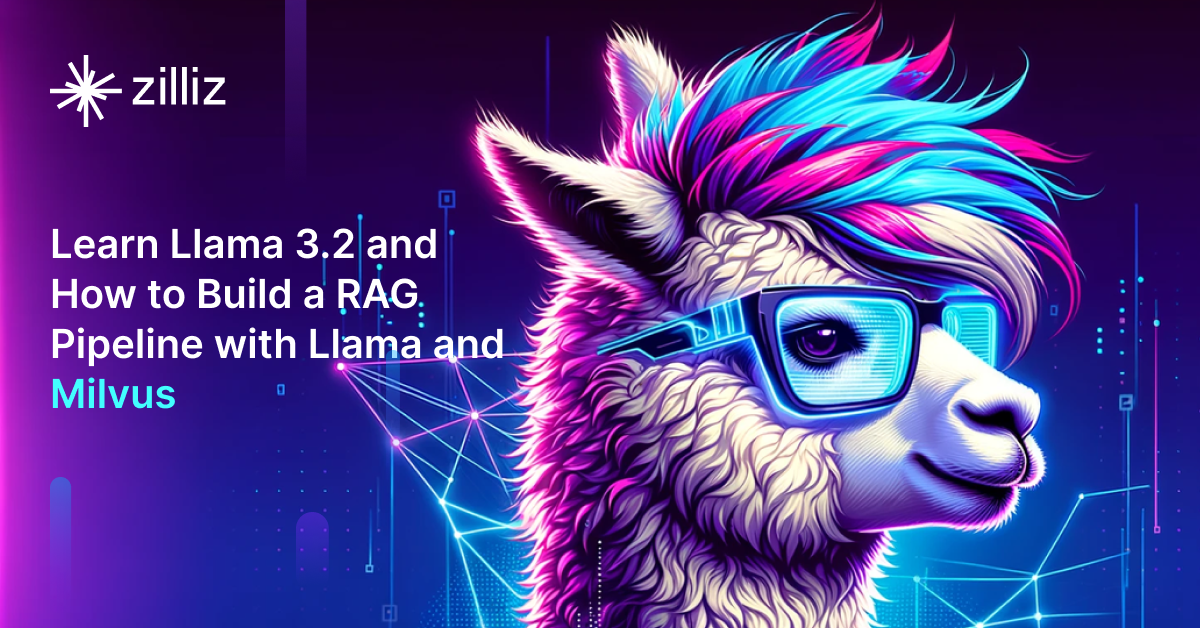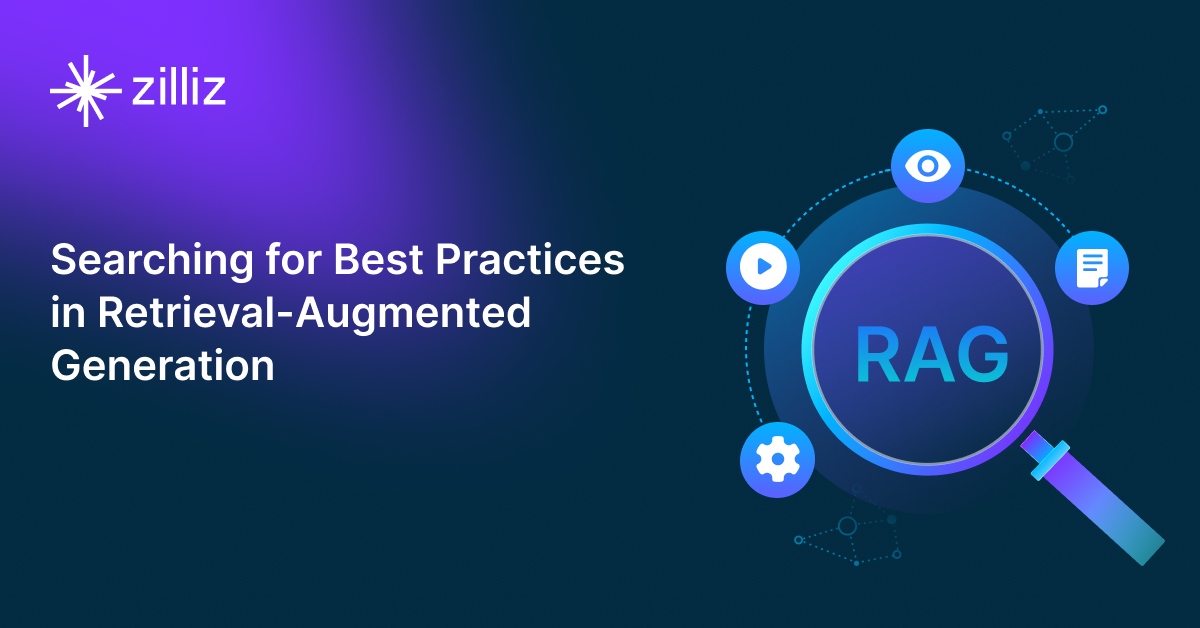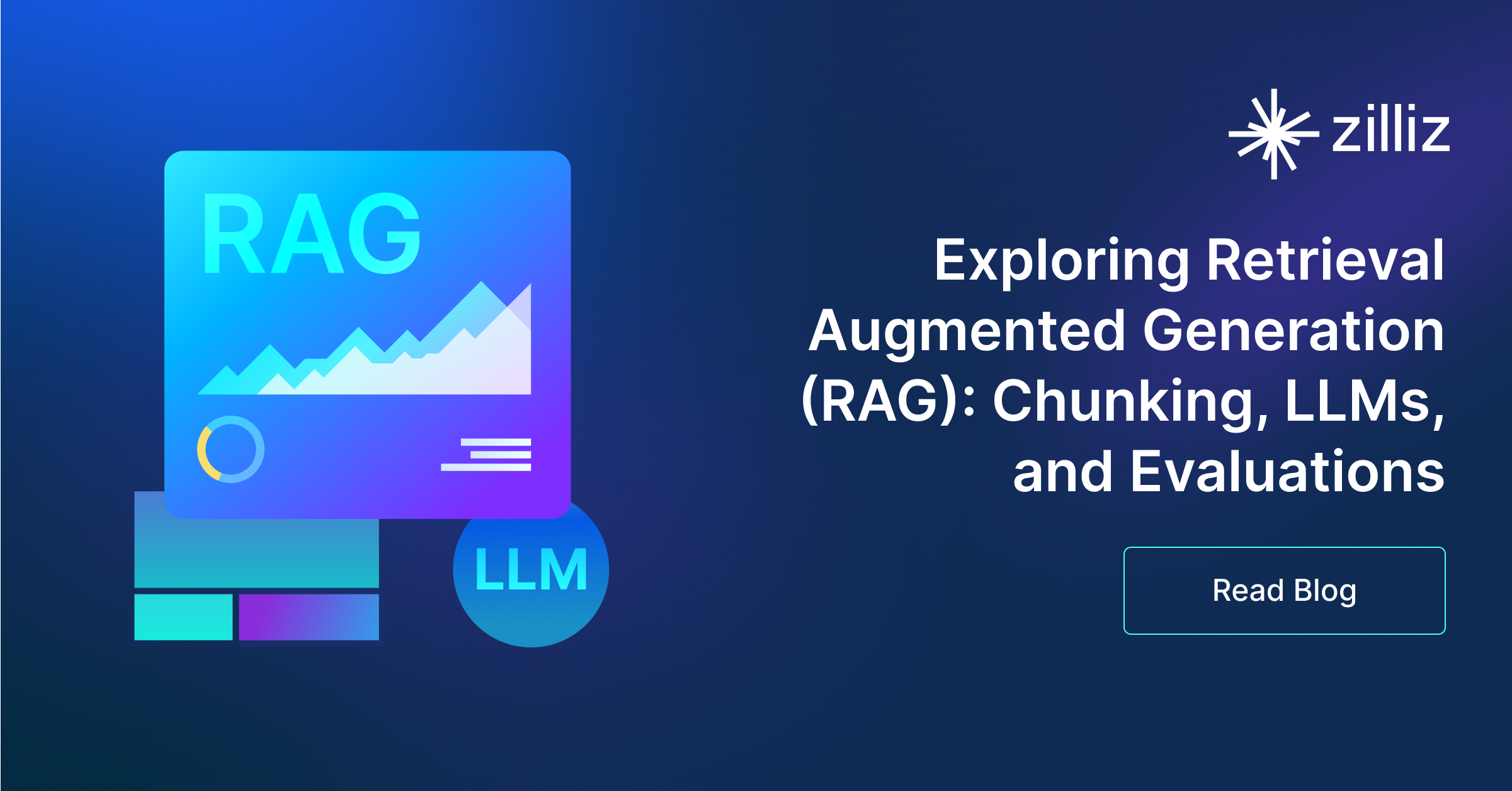Build RAG Chatbot with LangChain, Milvus, Azure GPT-4o mini, and mistral-embed
Introduction to RAG
Retrieval-Augmented Generation (RAG) is a game-changer for GenAI applications, especially in conversational AI. It combines the power of pre-trained large language models (LLMs) like OpenAI’s GPT with external knowledge sources stored in vector databases such as Milvus and Zilliz Cloud, allowing for more accurate, contextually relevant, and up-to-date response generation. A RAG pipeline usually consists of four basic components: a vector database, an embedding model, an LLM, and a framework.
Key Components We'll Use for This RAG Chatbot
This tutorial shows you how to build a simple RAG chatbot in Python using the following components:
- LangChain: An open-source framework that helps you orchestrate the interaction between LLMs, vector stores, embedding models, etc, making it easier to integrate a RAG pipeline.
- Milvus: An open-source vector database optimized to store, index, and search large-scale vector embeddings efficiently, perfect for use cases like RAG, semantic search, and recommender systems. If you hate to manage your own infrastructure, we recommend using Zilliz Cloud, which is a fully managed vector database service built on Milvus and offers a free tier supporting up to 1 million vectors.
- Azure GPT-4o Mini: A compact version of the powerful GPT-4 architecture, designed for efficient processing in resource-constrained environments. It delivers robust performance in natural language understanding and generation, making it suitable for chatbots, customer support, and content creation. Ideal for applications where speed and scalability are essential without compromising on quality.
- Mistral-Embed: Mistral-Embed is a cutting-edge embedding model designed for high-dimensional text representation. It excels in tasks such as semantic search, similarity measurement, and recommendation systems, providing accurate contextual embeddings. Ideal for enhancing NLP applications, it balances performance with scalability, making it suitable for both research and real-world implementations.
By the end of this tutorial, you’ll have a functional chatbot capable of answering questions based on a custom knowledge base.
Note: Since we may use proprietary models in our tutorials, make sure you have the required API key beforehand.
Step 1: Install and Set Up LangChain
%pip install --quiet --upgrade langchain-text-splitters langchain-community langgraph
Step 2: Install and Set Up Azure GPT-4o mini
pip install -qU "langchain[openai]"
import getpass
import os
if not os.environ.get("AZURE_OPENAI_API_KEY"):
os.environ["AZURE_OPENAI_API_KEY"] = getpass.getpass("Enter API key for Azure: ")
from langchain_openai import AzureChatOpenAI
llm = AzureChatOpenAI(
azure_endpoint=os.environ["AZURE_OPENAI_ENDPOINT"],
azure_deployment=os.environ["AZURE_OPENAI_DEPLOYMENT_NAME"],
openai_api_version=os.environ["AZURE_OPENAI_API_VERSION"],
)
Step 3: Install and Set Up mistral-embed
pip install -qU langchain-mistralai
import getpass
import os
if not os.environ.get("MISTRALAI_API_KEY"):
os.environ["MISTRALAI_API_KEY"] = getpass.getpass("Enter API key for MistralAI: ")
from langchain_mistralai import MistralAIEmbeddings
embeddings = MistralAIEmbeddings(model="mistral-embed")
Step 4: Install and Set Up Milvus
pip install -qU langchain-milvus
from langchain_milvus import Milvus
vector_store = Milvus(embedding_function=embeddings)
Step 5: Build a RAG Chatbot
Now that you’ve set up all components, let’s start to build a simple chatbot. We’ll use the Milvus introduction doc as a private knowledge base. You can replace it with your own dataset to customize your RAG chatbot.
import bs4
from langchain import hub
from langchain_community.document_loaders import WebBaseLoader
from langchain_core.documents import Document
from langchain_text_splitters import RecursiveCharacterTextSplitter
from langgraph.graph import START, StateGraph
from typing_extensions import List, TypedDict
# Load and chunk contents of the blog
loader = WebBaseLoader(
web_paths=("https://milvus.io/docs/overview.md",),
bs_kwargs=dict(
parse_only=bs4.SoupStrainer(
class_=("doc-style doc-post-content")
)
),
)
docs = loader.load()
text_splitter = RecursiveCharacterTextSplitter(chunk_size=1000, chunk_overlap=200)
all_splits = text_splitter.split_documents(docs)
# Index chunks
_ = vector_store.add_documents(documents=all_splits)
# Define prompt for question-answering
prompt = hub.pull("rlm/rag-prompt")
# Define state for application
class State(TypedDict):
question: str
context: List[Document]
answer: str
# Define application steps
def retrieve(state: State):
retrieved_docs = vector_store.similarity_search(state["question"])
return {"context": retrieved_docs}
def generate(state: State):
docs_content = "\n\n".join(doc.page_content for doc in state["context"])
messages = prompt.invoke({"question": state["question"], "context": docs_content})
response = llm.invoke(messages)
return {"answer": response.content}
# Compile application and test
graph_builder = StateGraph(State).add_sequence([retrieve, generate])
graph_builder.add_edge(START, "retrieve")
graph = graph_builder.compile()
Test the Chatbot
Yeah! You've built your own chatbot. Let's ask the chatbot a question.
response = graph.invoke({"question": "What data types does Milvus support?"})
print(response["answer"])
Example Output
Milvus supports various data types including sparse vectors, binary vectors, JSON, and arrays. Additionally, it handles common numerical and character types, making it versatile for different data modeling needs. This allows users to manage unstructured or multi-modal data efficiently.
Optimization Tips
As you build your RAG system, optimization is key to ensuring peak performance and efficiency. While setting up the components is an essential first step, fine-tuning each one will help you create a solution that works even better and scales seamlessly. In this section, we’ll share some practical tips for optimizing all these components, giving you the edge to build smarter, faster, and more responsive RAG applications.
LangChain optimization tips
To optimize LangChain, focus on minimizing redundant operations in your workflow by structuring your chains and agents efficiently. Use caching to avoid repeated computations, speeding up your system, and experiment with modular design to ensure that components like models or databases can be easily swapped out. This will provide both flexibility and efficiency, allowing you to quickly scale your system without unnecessary delays or complications.
Milvus optimization tips
Milvus serves as a highly efficient vector database, critical for retrieval tasks in a RAG system. To optimize its performance, ensure that indexes are properly built to balance speed and accuracy; consider utilizing HNSW (Hierarchical Navigable Small World) for efficient nearest neighbor search where response time is crucial. Partitioning data based on usage patterns can enhance query performance and reduce load times, enabling better scalability. Regularly monitor and adjust cache settings based on query frequency to avoid latency during data retrieval. Employ batch processing for vector insertions, which can minimize database lock contention and enhance overall throughput. Additionally, fine-tune the model parameters by experimenting with the dimensionality of the vectors; higher dimensions can improve retrieval accuracy but may increase search time, necessitating a balance tailored to your specific use case and hardware infrastructure.
Azure GPT-4o mini optimization tips
Azure GPT-4o mini is a cost-efficient, low-latency model optimized for fast RAG applications. Improve retrieval by ensuring only the top-ranked, most relevant documents are included in the context to minimize unnecessary token consumption. Structure prompts with bullet points or numbered lists for clarity. Adjust temperature settings between 0.1 and 0.2 for precision, modifying top-p as needed for response diversity. To enhance performance, batch multiple API requests and implement caching for frequently queried information. Azure’s infrastructure allows for auto-scaling, so configure dynamic scaling to handle varying workloads efficiently. Stream responses for improved real-time performance, ensuring fast and interactive user experiences. If used in a pipeline, assign GPT-4o mini to preliminary filtering or summarization while reserving larger models for complex tasks.
mistral-embed optimization tips
mistral-embed is a versatile embedding model suitable for diverse text-based RAG applications. To enhance retrieval, optimize embedding quality by fine-tuning on domain-specific data to capture nuanced semantic relationships. Use efficient vector search techniques like FAISS or HNSW to quickly identify relevant documents from large datasets. For better storage management, compress embeddings without sacrificing accuracy, such as through quantization or dimensionality reduction. To maximize throughput, batch embedding requests and use multi-threading to parallelize computations. Regularly update the embedding store with new data to ensure freshness and accuracy in retrieval. Optimize model performance by tuning hyperparameters such as temperature and top-k to balance precision and diversity in retrieved results.
By implementing these tips across your components, you'll be able to enhance the performance and functionality of your RAG system, ensuring it’s optimized for both speed and accuracy. Keep testing, iterating, and refining your setup to stay ahead in the ever-evolving world of AI development.
RAG Cost Calculator: A Free Tool to Calculate Your Cost in Seconds
Estimating the cost of a Retrieval-Augmented Generation (RAG) pipeline involves analyzing expenses across vector storage, compute resources, and API usage. Key cost drivers include vector database queries, embedding generation, and LLM inference.
RAG Cost Calculator is a free tool that quickly estimates the cost of building a RAG pipeline, including chunking, embedding, vector storage/search, and LLM generation. It also helps you identify cost-saving opportunities and achieve up to 10x cost reduction on vector databases with the serverless option.
 Calculate your RAG cost
Calculate your RAG cost
What Have You Learned?
What Have You Learned?
Wow! What a journey you've just embarked on together! You've dived deep into the world of cutting-edge technologies, integrating a versatile framework with a robust vector database, a powerful LLM (like Azure GPT-4o mini), and an advanced embedding model (like mistral-embed) to build a state-of-the-art Retrieval-Augmented Generation (RAG) system. Each component plays a vital role: the framework seamlessly ties everything together, ensuring smooth interactions and functionality. The vector database provides you with lightning-fast search capabilities, enabling you to access relevant information in no time. Meanwhile, the LLM powers up your conversations with intelligent responses, creating engaging user experiences. And let's not forget the embedding model, which generates rich semantic representations, allowing your system to understand context and nuances in data like never before.
We’ve even shared some handy optimization tips and introduced a free cost calculator, empowering you to build and scale your applications without breaking the bank. Now, as you stand on the cusp of innovation, I encourage you to let your imagination run wild! Start building, optimizing, and innovating your own RAG applications. Your creativity and enthusiasm can lead to groundbreaking discoveries, transforming the way we interact with information. So, dig in, experiment, and most importantly, have fun as you create the future! The world is waiting for your brilliance!
Further Resources
🌟 In addition to this RAG tutorial, unleash your full potential with these incredible resources to level up your RAG skills.
- How to Build a Multimodal RAG | Documentation
- How to Enhance the Performance of Your RAG Pipeline
- Graph RAG with Milvus | Documentation
- How to Evaluate RAG Applications - Zilliz Learn
- Generative AI Resource Hub | Zilliz
We'd Love to Hear What You Think!
We’d love to hear your thoughts! 🌟 Leave your questions or comments below or join our vibrant Milvus Discord community to share your experiences, ask questions, or connect with thousands of AI enthusiasts. Your journey matters to us!
If you like this tutorial, show your support by giving our Milvus GitHub repo a star ⭐—it means the world to us and inspires us to keep creating! 💖
- Introduction to RAG
- Key Components We'll Use for This RAG Chatbot
- Step 1: Install and Set Up LangChain
- Step 2: Install and Set Up Azure GPT-4o mini
- Step 3: Install and Set Up mistral-embed
- Step 4: Install and Set Up Milvus
- Step 5: Build a RAG Chatbot
- Optimization Tips
- RAG Cost Calculator: A Free Tool to Calculate Your Cost in Seconds
- What Have You Learned?
- Further Resources
- We'd Love to Hear What You Think!
Content
Vector Database at Scale
Zilliz Cloud is a fully-managed vector database built for scale, perfect for your RAG apps.
Try Zilliz Cloud for Free


